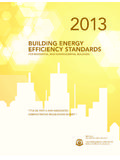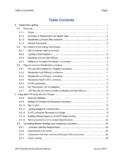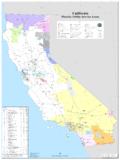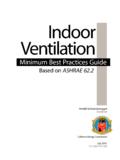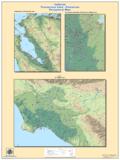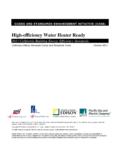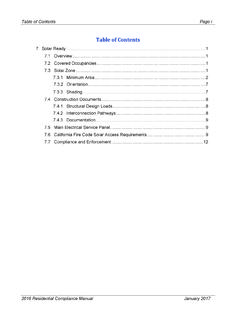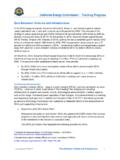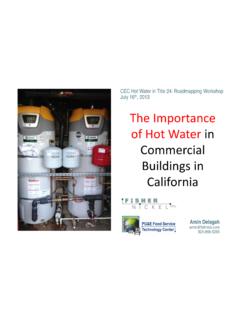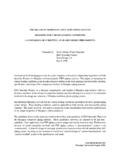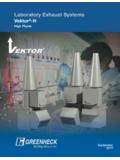Transcription of 2016 Building Energy Efficiency Standards for …
1 Building Energy Efficiency Standards FOR RESIDENTIAL AND NONRESIDENTIAL BUILDINGSFOR THE 201 6 Building Energy Efficiency STANDARDSTITLE 24, P ART 6, AND ASS OCIATED ADMINISTRATIVE REGULATIONS IN PART 2015 CEC-400-2015-037-CMFCALIFORNIA Energy COMMISSIONE dmund G. Brown Jr., Governor CALIFORNIA Energy COMMISSION Robert B. Weisenmiller, Chair Commissioners Karen Douglas, Andrew McAllister David Hochschild Janea A. Scott, Maziar Shirakh, Peter Strait Project Managers Eurlyne Geiszler Manager Building Standards Office David Ashuckian Deputy Director Efficiency Division Robert P. Oglesby Executive Director (This page left intentionally blank) ABSTRACT The Building Energy Efficiency Standards were first adopted in 1976 and have been updated periodically since then as directed by statute. In 1975 the Department of Housing and Community Development adopted rudimentary Energy conservation Standards under their State Housing Law authority that were a precursor to the first generation of the Standards .
2 However, the Warren-Alquist Act was passed one year earlier with explicit direction to the Energy Commission (formally titled the State Energy Resources Conservation and Development Commission) to adopt and implement the Standards . The Energy Commission s statute created separate authority and specific direction regarding what the Standards are to address, what criteria are to be met in developing the Standards , and what implementation tools, aids, and technical assistance are to be provided. The Standards contain Energy and water Efficiency requirements (and indoor air quality requirements) for newly constructed buildings, additions to existing buildings, and alterations to existing buildings. Public Resources Code Sections 25402 subdivisions (a)-(b) and emphasize the importance of Building design and construction flexibility by requiring the Energy Commission to establish performance Standards , in the form of an Energy budget in terms of the Energy consumption per square foot of floor space.
3 For this reason, the Standards include both a prescriptive option, allowing builders to comply by using methods known to be efficient, and a performance option, allowing builders complete freedom in their designs provided the Building achieves the same overall Efficiency as an equivalent Building using the prescriptive option. Reference Appendices are adopted along with the Standards that contain data and other information that helps builders comply with the Standards . The 2016 update to the Building Energy Efficiency Standards focuses on several key areas to improve the Energy Efficiency of newly constructed buildings and additions and alterations to existing buildings. The most significant Efficiency improvements to the residential Standards include improvements for attics, walls, water heating, and lighting. The most significant Efficiency improvements to the nonresidential Standards include alignment with the ASHRAE 2013 national Standards .
4 New Efficiency requirements for elevators and direct digital controls are included in the nonresidential Standards . The 2016 Standards also include changes made throughout all of its sections to improve the clarity, consistency, and readability of the regulatory language. Public Resources Code Section also requires the Energy Commission to support the performance Standards with compliance tools for builders and Building designers. The Alternative Calculation Method (ACM) Approval Manual adopted by regulation as an appendix of the Standards establishes requirements for input, output and calculational uniformity in the computer programs used to demonstrate compliance with the Standards . From this, the Energy Commission develops and makes publicly available free, public domain Building modeling software in order to enable compliance based on modeling of Building Efficiency and performance. The ACM Approval Manual also includes provisions for private firms seeking to develop compliance software for approval by the Energy Commission, which further encourages flexibility and innovation.
5 The Standards are divided into three basic sets. First, there is a basic set of mandatory requirements that apply to all buildings. Second, there is a set of performance Standards the Energy budgets that vary by climate zone (of which there are 16 in California) and Building type; thus the Standards are tailored to local conditions. Finally, the third set constitutes an alternative to the performance Standards , which is a set of prescriptive packages that are basically a recipe or a checklist compliance approach. A summary outline of the Standards is as follows: The administrative regulations for the Standards are in Part 1, Chapter 10. Mandatory requirements that apply to all Building types are in Part 6, Sections The requirements for nonresidential buildings, high-rise residential buildings, and hotels/motels are in Part 6, Sections to and to Specialized mandatory requirements for such buildings are in Sections to ; the performance compliance approach is explained in Section ; nonresidential prescriptive packages are in Sections to ; and requirements for additions, alterations, and repairs to existing nonresidential buildings are in Section 141.
6 The requirements for low-rise residential buildings are in Part 6, Sections to Specialized mandatory requirements for these buildings are in Section ; the performance compliance approach is explained in Section ; prescriptive packages are in Section ; and requirements for additions and alterations to existing buildings are in Section Additional directions adopted to support the Standards in Part 6 are in the Reference Appendices: the Residential Appendices; the Nonresidential Appendices; the Joint Appendices; and the Alternative Calculation Method Approval Manual. Energy Commission staff completed an Initial Study of the environmental impacts of the 2016 Building Energy Efficiency Standards for residential and nonresidential buildings. In this Initial Study, Energy Commission staff estimated that the implementation of the 2016 Building Energy Efficiency Standards may reduce statewide annual electricity consumption by approximately 281 gigawatt hours per year, electrical peak demand by 195 megawatts, and natural gas consumption by 16 million therms per year.
7 The potential effect of these Energy savings to air quality may be a net reduction in the emission of nitric oxide by approximately 508 tons per year, sulfur oxides by 13 tons per year, carbon monoxide by 41 tons per year and particulate matter less than microns in diameter by tons per year. Additionally, Energy Commission staff estimated that the implementation of the 2016 Standards may reduce statewide greenhouse gas emissions by 160 thousand metric tons CO2e per year. Keywords: California Energy Commission Mandatory Envelope Insulation California Building Code Prescriptive HVAC California Building Energy Efficiency Standards Performance Building Commissioning Time Dependent Process Load Title 24, Part 6 Valuation Refrigeration 2016 Building Energy Efficiency Standards TDV Data Center Ducts in Conditioned Spaces Exhaust Residential High Performance Attics Compressed Air Nonresidential High Performance Walls Acceptance Testing Newly Constructed High Efficacy Lighting Data Collection Additions and Alterations to Existing Buildings Water Heating Cool Roof Windows On site Renewable 2016 Building Energy Efficiency Standards Page i TABLE OF CONTENTS ARTICLE 1 Energy Building REGULATIONS.
8 1 10-101 SCOPE .. 1 10-102 DEFINITIONS .. 2 10-103 PERMIT, CERTIFICATE, INFORMATIONAL, AND ENFORCEMENT REQUIREMENTS FOR DESIGNERS, INSTALLERS, BUILDERS, MANUFACTURERS, AND 6 NONRESIDENTIAL LIGHTING CONTROLS ACCEPTANCE TEST TRAINING AND CERTIFICATION .. 16 NONRESIDENTIAL MECHANICAL ACCEPTANCE TEST TRAINING AND CERTIFICATION .. 20 10-104 EXCEPTIONAL DESIGNS .. 25 10-105 ENFORCEMENT BY THE COMMISSION .. 26 10-106 LOCALLY ADOPTED Energy 27 10-107 INTERPRETATIONS .. 28 10-108 29 10-109 COMPLIANCE SOFTWARE, ALTERNATIVE COMPONENT PACKAGES, EXCEPTIONAL METHODS, DATA REGISTRIES AND RELATED DATA INPUT SOFTWARE, ALTERNATIVE RESIDENTIAL FIELD VERIFICATION PROTOCOLS, AND ELECTRONIC DOCUMENT REPOSITORIES .. 30 10-110 PROCEDURES FOR CONSIDERATION OF APPLICATIONS UNDER SECTIONS 10-104, 10-106, 10-108, AND 10-109 .. 33 10-111 CERTIFICATION AND LABELING OF FENESTRATION PRODUCT U-FACTORS, SOLAR HEAT GAIN COEFFICIENTS, VISIBLE TRANSMITTANCE AND AIR LEAKAGE.
9 34 10-112 CRITERIA FOR DEFAULT TABLES .. 37 10-113 CERTIFICATION AND LABELING OF ROOFING PRODUCT REFLECTANCE AND EMITTANCE .. 38 10-114 DETERMINATION OF OUTDOOR LIGHTING ZONES AND ADMINISTRATIVE RULES FOR USE .. 40 Efficiency Standards CALIFORNIA CODE OF REGULATIONS TITLE 24, PART 6 .. 43 SUBCHAPTER 1 ALL OCCUPANCIES GENERAL PROVISIONS .. 45 SECTION SCOPE .. 45 SECTION DEFINITIONS AND RULES OF 49 SECTION CALCULATION OF TIME DEPENDENT VALUATION (TDV) Energy .. 83 SUBCHAPTER 2 ALL OCCUPANCIES MANDATORY REQUIREMENTS FOR THE MANUFACTURE, CONSTRUCTION AND INSTALLATION OF SYSTEMS, EQUIPMENT AND Building COMPONENTS .. 85 SECTION SYSTEMS AND EQUIPMENT GENERAL .. 85 SECTION MANDATORY REQUIREMENTS FOR APPLIANCES .. 86 SECTION MANDATORY REQUIREMENTS FOR SPACE-CONDITIONING EQUIPMENT .. 87 SECTION MANDATORY REQUIREMENTS FOR SERVICE WATER-HEATING SYSTEMS AND EQUIPMENT .. 101 SECTION MANDATORY REQUIREMENTS FOR POOL AND SPA SYSTEMS AND EQUIPMENT.
10 103 SECTION NATURAL GAS CENTRAL FURNACES, COOKING EQUIPMENT, AND POOL AND SPA HEATERS: PILOT LIGHTS PROHIBITED .. 104 Table of Contents Page ii 2016 Building Energy Efficiency Standards SECTION MANDATORY REQUIREMENTS FOR FENESTRATION PRODUCTS AND EXTERIOR DOORS ..105 SECTION MANDATORY REQUIREMENTS TO LIMIT AIR LEAKAGE ..109 SECTION MANDATORY REQUIREMENTS FOR INSULATION, ROOFING PRODUCTS AND RADIANT BARRIERS ..110 SECTION MANDATORY REQUIREMENTS FOR LIGHTING CONTROL DEVICES AND SYSTEMS, BALLASTS, AND LUMINAIRES ..113 SECTION MANDATORY REQUIREMENTS FOR SOLAR READY BUILDINGS ..116 SECTION MANDATORY REQUIREMENTS FOR ELECTRICAL POWER DISTRIBUTION SUBCHAPTER 3 NONRESIDENTIAL, HIGH-RISE RESIDENTIAL, HOTEL/MOTEL OCCUPANCIES, AND COVERED PROCESSES MANDATORY REQUIREMENTS.
